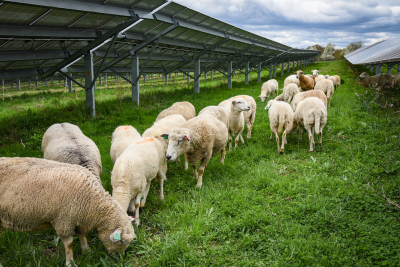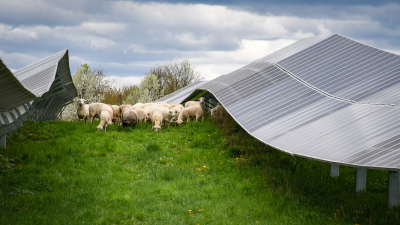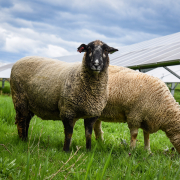Case Study: Solar Grazing at Susquehanna University
Some institutions of higher learning are reducing fossil fuel use by investing in solar panel installations on campus. However, most of them don’t use grazing sheep to manage the grassland under their panels. In 2019, Susquehanna University (SU) in Selinsgrove, Pennsylvania put into service a 14-acre, 3-megawatt solar system, located on its Center for Environmental Education and Research property. The school leases a flock of sheep from Owens Farm, located near the University in Sunbury, Pennsylvania, to act as natural lawn mowers for the fenced solar array.
This solar project is a partnership between the university and WGL Energy Systems. WGL owns and operates the facility under a 25-year power purchase agreement (PPA), and Susquehanna purchases electricity back from WGL. Commercial PPAs such as this allow organizations like SU to buy power directly from the generating company and not an electric utility. This arrangement gives the generation company an incentive to invest in renewable generation installations, which is a key part of financing projects like this. A second company, SCG Power, provided design and construction services to the project.

Katahdin sheep grazing the grass aisles between solar panels. Photo: Susquehanna University
Caroline Owens of Owens Farm said that she dedicates 40 of her farm’s Katahdin sheep to fulfill the solar grazing contract with the university. Owens raises more than 100 sheep and works with the university to provide managed grazing under the panels throughout the pasture season each year. Owens is a member of the American Solar Grazing Association (ASGA), an organization promoting best practices for grazing livestock under solar panels. According to ASGA, solar grazing is one of the most common and effective ways to combine solar and agriculture, and sheep are among the best livestock choices for the task.

Sheep grazing in solar fields utilize the shade provided by the panels. Photo: Susquehanna University
Though Owens Farm is paid by Susquehanna University for the grazing services provided, the arrangement is mutually beneficial: Owens Farm gets extra income and access to more grazing land, and the university gets well managed vegetation, which is essential for optimal performance of the solar array. Both Owens Farm and the university are happy for the opportunity to show a working example of their shared commitment to reducing fossil fuel use. The partnership has another benefit, too, in the form of a learning opportunity each year for a Susquehanna University student who gets to be a shepherd for a season and help manage the flock.



